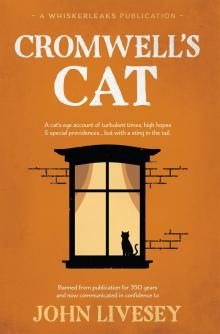- Home
- John Livesey
Cromwell's Cat Page 22
Cromwell's Cat Read online
Page 22
Edward Sexby (1616 - 1658) & Maximilian Petty (1617 - 1661)
Radical spokesmen at Putney with very divergent histories. Sexby rose to be a lieutenant-colonel in the army, to be a secret government emissary to the ‘Ormistes’ – like-minded radicals in Bordeaux, and finally under the protectorate to be a conspirator, collaborating with royalists and plotting Cromwell’s attempted murder. Petty, a civilian, a year later joined with Lilburne in working with Ireton to draft the second ‘Agreement of the People’. It is not known whether he joined Lilburne in disowning it when Ireton presented it first to the Council of Officers for approval and then to parliament (20th January 1649).
Sir Henry Slingbsy (1602 – 1658)
Yorkshire royalist imprisoned in Hull after the failed rising of 1655 and who, three years later after an even more spectacularly ill-planned attempted rising and invasion was tried by a specially convened High Court of Justice (only the second of the Protectorate) and executed on Tower Hill on 8th June 1658. While in Hull Slingsby had approached garrison officers to persuade them to deliver over the town to the royalists. They played him along, under orders, until he handed over a Commission from Charles to be governor of Hull. This gave the government the hard evidence they needed and so, when in 1658, the planned rising was predicated on the royalists in England capturing a port where a Spanish fleet could land a royalist army, from the government’s point of view the critical factor was control of the port: the vast majority of royalists in England would not rise nor would the Spaniards set sail without it. Slingsby (unimportant in himself) was executed to make a political point.
Sir Henry Vane (the younger) 1613 – 1662
Religious radical, renowned parliamentarian, from an early date attached to the ‘War Party’ and Cromwell’s ally there on many crucial matters. In December 1644 he seconded the Self-Denying Ordinance (see above) and in 1647 he was among those who helped Ireton & Cromwell draw up the Heads of Proposals. Then in December 1648 he was one of parliament’s commissioners treating with the king at Newport but in the Commons argued in vain against the terms agreed being accepted as a sufficient ground for proceeding to settlement. ‘Pride’s Purge’ (see above) was the result and Vane was among those who withdrew from parliament in protest. At Cromwell’s urging he resumed his seat in February 1649 and was a pivotal figure in the government for the next four years – particularly in the overhaul of naval administration leading to victory in the Anglo-Dutch War and in agreeing terms for the union of England and Scotland. He parted company with Cromwell at the dissolution of the Rump on 20th April 1653. Though not a regicide he was imprisoned at the restoration, tried for treason and executed in 1662.
Notes
1A timeline for the period covered in the story can be found at http://bcw-project.org/timelines/, while additional information on events or individuals marked * in the text, can be found in the Appendix.
2When Cromwell addressed the Nominated Parliament on 4th July 1653 and recalled the events of ‘that memorable year (1648)’ he specifically included ‘the king removed and brought to justice’, which only happened in January 1649.
3Alan, Catriona, Rhodri (& Karen)
4The king will henceforth be identified as ‘Maj’ in column at left – that being the name Tomkins now increasingly settles on.
5Rumoured at the time to include the notorious Colonel Blood (Thomason Tract E470 (4) ‘This being a bold and desperate adventure, Mr Blood was by most people adjudged the contriver…but he frequently disowned the fact’

 Cromwell's Cat
Cromwell's Cat